By Cris D. Putnam
 The view of an antichrist pope dominated the late nineteenth and early twentieth century. Even Catholics came to similar conclusions. George Tyrrell, a Jesuit priest and controversial modernist theologian, was excommunicated in 1908 after he also came to the conclusion that papacy was antichrist. He stated,
The view of an antichrist pope dominated the late nineteenth and early twentieth century. Even Catholics came to similar conclusions. George Tyrrell, a Jesuit priest and controversial modernist theologian, was excommunicated in 1908 after he also came to the conclusion that papacy was antichrist. He stated,
“I believe in the Roman Church so far as it is Christian and Catholic; I disbelieve in it so far as it is papal. I see two spirits in it, as in myself, struggling for supremacy—Light and Darkness, Christ and Anti-Christ; God and the Devil.”[1]
Another figure in turn of the century theology, Charles Hodge, who served at Princeton theological seminary from 1872 to 1929, also argues convincingly that the papacy is antichrist. His treatment of the antichrist in his Systematic Theologyis so influential that it will also be examined more thoroughly.

Charles Hodge: "But to be the Vicar of Christ, to claim to exercise his prerogatives on earth, does involve a claim to his attributes, and therefore our opposition to Popery is opposition to a man claiming to be God."
One can readily see why Turretin’s theology text’s remarkable shelf life at Princeton was ended by Hodge. It is a pleasure to read and study Hodge’s work as he has a more winsome style and is more exegetically coherent. If the reader has any lingering doubt about the notion that the papacy is a manifestation of antichrist, studying Hodge will likely persuade. Hodge makes most of the same points as Turretin and the other reformers but he allows more flexibility. That tractability and his rigorous intellectual honesty are his strong points. Keeping in mind this work was published at the dawn of the twentieth century, Hodge addresses the “temple of God” reference in 2 Thessalonians: “Some, however, suppose that the reference is to the literal temple in Jerusalem; but this supposes, (a.) That the Jews are to be restored to their own land. (b.) That they are to be restored as Jews, or unconverted, and that the temple is to be there rebuilt.”[2]
While Hodge was incredulous it would ever occur, it is more than a little exciting that since this writing the Jews have been restored to their land and that they are planning to rebuild the temple, already having placed a cornerstone, and still in an unconverted state.[3] As discussed elsewhere, even more persuasive is the possibility that Rome is driving the process. Hodge clearly believed the papacy was antichrist. He demolishes Anglican turncoat John Henry Newman’s argument that this line of reasoning necessarily condemns all Catholic believers. He argues it is a non-sequitur because the Church of Rome can be understood in different aspects, the arrogant hierarchy of the papacy and the body of professing believers. He breaks new ground in reformed polemics by generously offering, “That many Roman Catholics, past and present, are true Christians, is a palpable fact.”[4] This is refreshing because it does not necessarily follow that the papacy being part of the antichrist system damns all Catholics.
Additionally, he does not rigidly rule out other manifestations like Turretin. He states, “Admitting that the Apostle’s predictions refer to the Roman pontiffs, it does not follow that the papacy is the only antichrist.”[5] This accounts for John’s teaching that the Antichrist (singular) is coming as many antichrists had come (1 Jn 2:18). Hodge carries this line of thinking further offering, “the same power, retaining all its essential characteristics, may change its form.”[6] His intellectual honesty in accounting for more than one potential manifestation is inspirational. As noted above, Wesley and Spurgeon were also sympathetic to the possibility of an ultimate future Antichrist just prior to Jesus’ return. Is it possible that papacy still might fulfill this ultimate sense as well? Could there be a satanic presence in the Vatican which is leading toward that final confrontation? There is fascinating evidence presented in Petrus Romanus: the Final Pope is Here which suggests it.
[1] David F. Wells, “The Pope as Antichrist: The Substance of George Tyrrell’s Polemic” (Harvard Theological Review 65, 2 April 1972) 271–283.
[2] Charles Hodge, Systematic Theology, 3:815.
[3] “The Temple Mount Faithful Movement Held On ‘Jerusalem Day” the Most Exciting Event in Israel Since the Destruction of the Holy Temple in 70 CE,” TempleMountFaithful.org, last accessed October, 11, 2011, http://www.templemountfaithful.org/Events/jerusalemDay2009-2.htm.
[4] Charles Hodge, Systematic Theology, 3:822.
[5] Ibid.
[6] Ibid., 3:825.










